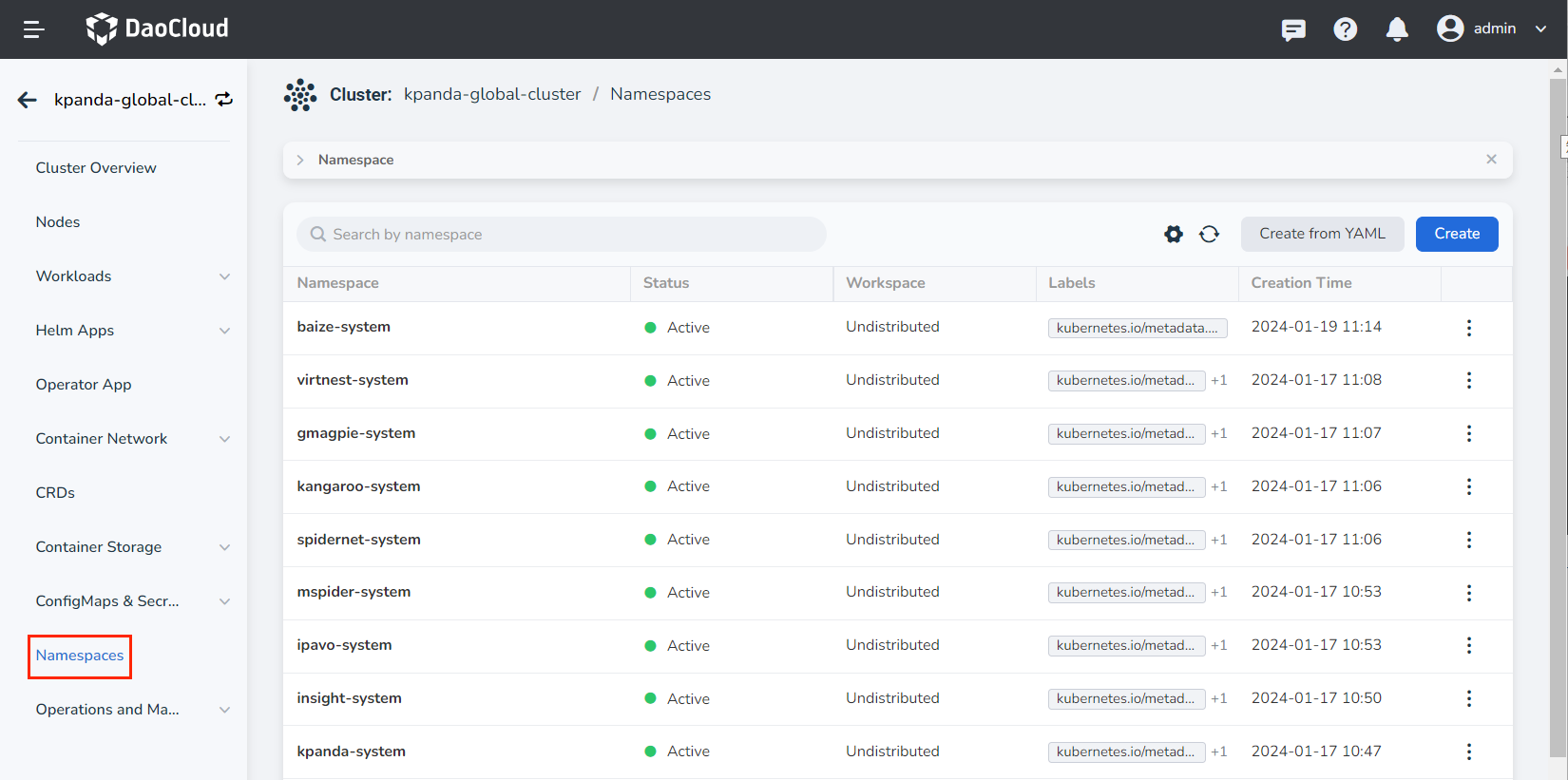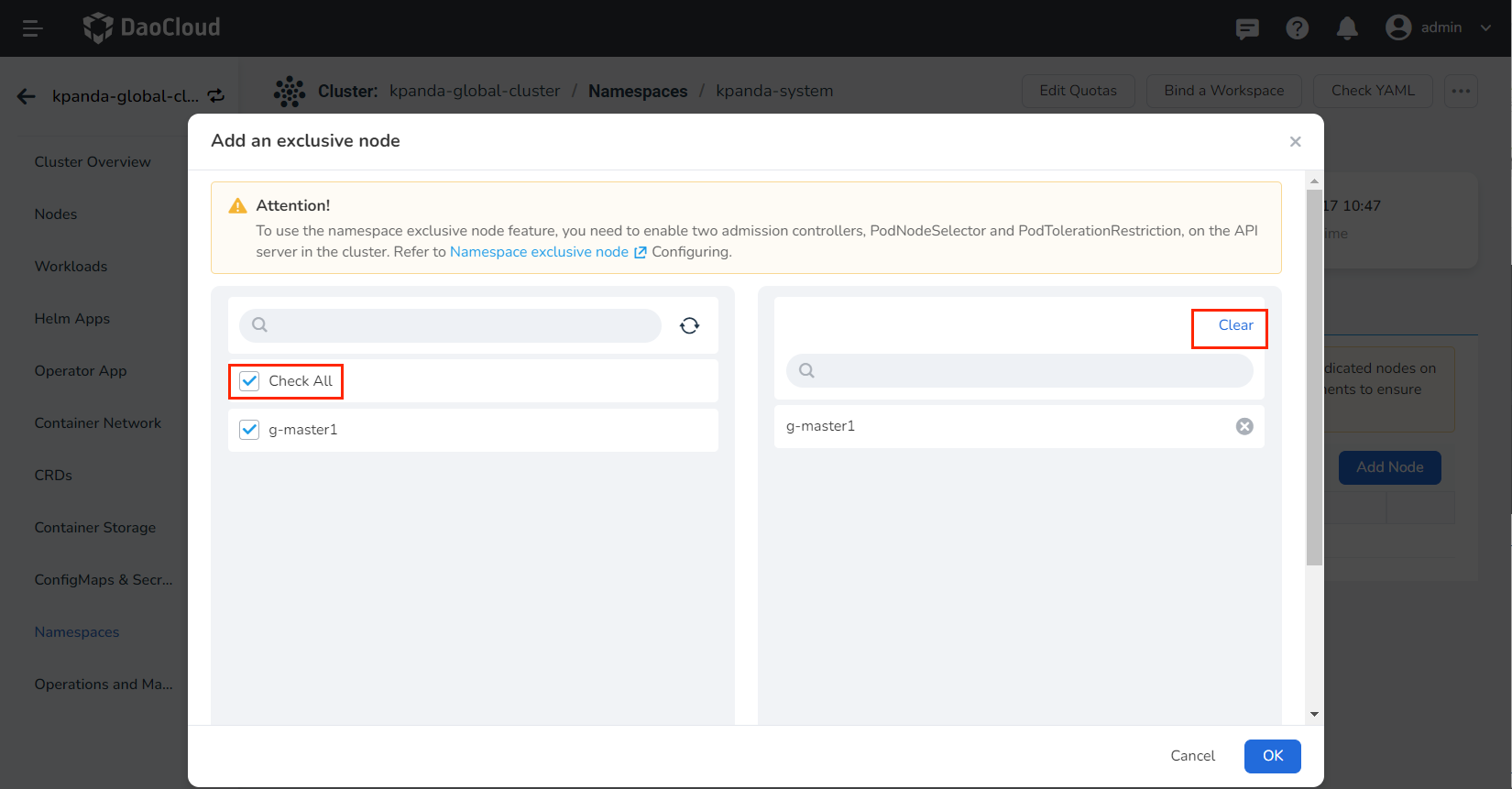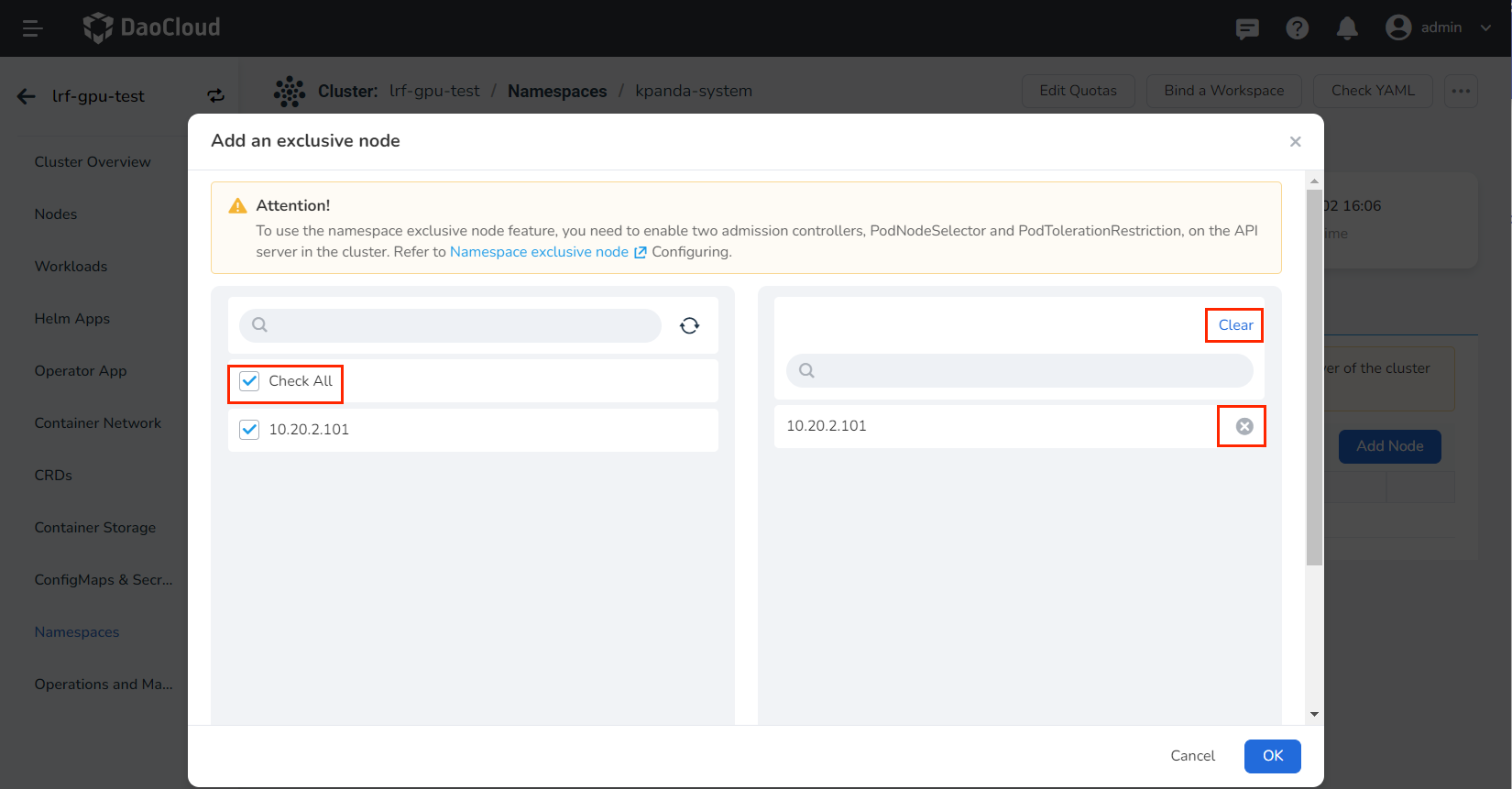Namespace Exclusive Nodes¶
Namespace exclusive nodes in a Kubernetes cluster allow a specific namespace to have exclusive access to one or more node's CPU, memory, and other resources through taints and tolerations. Once exclusive nodes are configured for a specific namespace, applications and services from other namespaces cannot run on the exclusive nodes. Using exclusive nodes allows important applications to have exclusive access to some computing resources, achieving physical isolation from other applications.
Note
Applications and services running on a node before it is set to be an exclusive node will not be affected and will continue to run normally on that node. Only when these Pods are deleted or rebuilt will they be scheduled to other non-exclusive nodes.
Preparation¶
Check whether the kube-apiserver of the current cluster has enabled the PodNodeSelector and PodTolerationRestriction admission controllers.
The use of namespace exclusive nodes requires users to enable the PodNodeSelector and PodTolerationRestriction admission controllers on the kube-apiserver. For more information about admission controllers, refer to Kubernetes Admission Controllers Reference.
You can go to any Master node in the current cluster to check whether these two features are enabled in the kube-apiserver.yaml file, or you can execute the following command on the Master node for a quick check:
[root@g-master1 ~]# cat /etc/kubernetes/manifests/kube-apiserver.yaml | grep enable-admission-plugins
# The expected output is as follows:
- --enable-admission-plugins=NodeRestriction,PodNodeSelector,PodTolerationRestriction
Enable Namespace Exclusive Nodes on Global Cluster¶
Since the Global cluster runs platform basic components such as kpanda, ghippo, and insight, enabling namespace exclusive nodes on Global may cause system components to not be scheduled to the exclusive nodes when they restart, affecting the overall high availability of the system. Therefore, we generally do not recommend users to enable the namespace exclusive node feature on the Global cluster.
If you do need to enable namespace exclusive nodes on the Global cluster, please follow the steps below:
-
Enable the PodNodeSelector and PodTolerationRestriction admission controllers for the kube-apiserver of the Global cluster
Note
If the cluster has already enabled the above two admission controllers, please skip this step and go directly to configure system component tolerations.
Go to any Master node in the current cluster to modify the kube-apiserver.yaml configuration file, or execute the following command on the Master node for configuration:
[root@g-master1 ~]# vi /etc/kubernetes/manifests/kube-apiserver.yaml # The expected output is as follows: apiVersion: v1 kind: Pod metadata: ...... spec: containers: - command: - kube-apiserver ...... - --default-not-ready-toleration-seconds=300 - --default-unreachable-toleration-seconds=300 - --enable-admission-plugins=NodeRestriction # List of enabled admission controllers - --enable-aggregator-routing=False - --enable-bootstrap-token-auth=true - --endpoint-reconciler-type=lease - --etcd-cafile=/etc/kubernetes/ssl/etcd/ca.crt ......Find the --enable-admission-plugins parameter and add the PodNodeSelector and PodTolerationRestriction admission controllers (separated by commas). Refer to the following:
-
Add toleration annotations to the namespace where the platform components are located
After enabling the admission controllers, you need to add toleration annotations to the namespace where the platform components are located to ensure the high availability of the platform components.
The system component namespaces for AI platform are as follows:
Namespace System Components Included kpanda-system kpanda hwameiStor-system hwameiStor istio-system istio metallb-system metallb cert-manager-system cert-manager contour-system contour kubean-system kubean ghippo-system ghippo kcoral-system kcoral kcollie-system kcollie insight-system insight, insight-agent: ipavo-system ipavo kairship-system kairship karmada-system karmada amamba-system amamba, jenkins skoala-system skoala mspider-system mspider mcamel-system mcamel-rabbitmq, mcamel-elasticsearch, mcamel-mysql, mcamel-redis, mcamel-kafka, mcamel-minio, mcamel-postgresql spidernet-system spidernet kangaroo-system kangaroo gmagpie-system gmagpie dowl-system dowl Check whether there are the above namespaces in the current cluster, execute the following command, and add the annotation:
scheduler.alpha.kubernetes.io/defaultTolerations: '[{"operator": "Exists", "effect": "NoSchedule", "key": "ExclusiveNamespace"}]'for each namespace.Make sure to replacekubectl annotate ns <namespace-name> scheduler.alpha.kubernetes.io/defaultTolerations: '[{"operator": "Exists", "effect": "NoSchedule", "key": "ExclusiveNamespace"}]'<namespace-name>with the name of the platform namespace you want to add the annotation to. -
Use the interface to set exclusive nodes for the namespace
After confirming that the PodNodeSelector and PodTolerationRestriction admission controllers on the cluster API server have been enabled, please follow the steps below to use the AI platform UI management interface to set exclusive nodes for the namespace.
-
Click the cluster name in the cluster list page, then click Namespace in the left navigation bar.

-
Click the namespace name, then click the Exclusive Node tab, and click Add Node on the bottom right.

-
Select which nodes you want to be exclusive to this namespace on the left side of the page. On the right side, you can clear or delete a selected node. Finally, click OK at the bottom.

-
You can view the current exclusive nodes for this namespace in the list. You can choose to Stop Exclusivity on the right side of the node.
After cancelling exclusivity, Pods from other namespaces can also be scheduled to this node.

-
Enable Namespace Exclusive Nodes on Non-Global Clusters¶
To enable namespace exclusive nodes on non-Global clusters, please follow the steps below:
-
Enable the PodNodeSelector and PodTolerationRestriction admission controllers for the kube-apiserver of the current cluster
Note
If the cluster has already enabled the above two admission controllers, please skip this step and go directly to using the interface to set exclusive nodes for the namespace.
Go to any Master node in the current cluster to modify the kube-apiserver.yaml configuration file, or execute the following command on the Master node for configuration:
[root@g-master1 ~]# vi /etc/kubernetes/manifests/kube-apiserver.yaml # The expected output is as follows: apiVersion: v1 kind: Pod metadata: ...... spec: containers: - command: - kube-apiserver ...... - --default-not-ready-toleration-seconds=300 - --default-unreachable-toleration-seconds=300 - --enable-admission-plugins=NodeRestriction #List of enabled admission controllers - --enable-aggregator-routing=False - --enable-bootstrap-token-auth=true - --endpoint-reconciler-type=lease - --etcd-cafile=/etc/kubernetes/ssl/etcd/ca.crt ......Find the --enable-admission-plugins parameter and add the PodNodeSelector and PodTolerationRestriction admission controllers (separated by commas). Refer to the following:
-
Use the interface to set exclusive nodes for the namespace
After confirming that the PodNodeSelector and PodTolerationRestriction admission controllers on the cluster API server have been enabled, please follow the steps below to use the AI platform UI management interface to set exclusive nodes for the namespace.
-
Click the cluster name in the cluster list page, then click Namespace in the left navigation bar.

-
Click the namespace name, then click the Exclusive Node tab, and click Add Node on the bottom right.

-
Select which nodes you want to be exclusive to this namespace on the left side of the page. On the right side, you can clear or delete a selected node. Finally, click OK at the bottom.

-
You can view the current exclusive nodes for this namespace in the list. You can choose to Stop Exclusivity on the right side of the node.
After cancelling exclusivity, Pods from other namespaces can also be scheduled to this node.

-
-
Add toleration annotations to the namespace where the components that need high availability are located (optional)
Execute the following command to add the annotation:
scheduler.alpha.kubernetes.io/defaultTolerations: '[{"operator": "Exists", "effect": "NoSchedule", "key": "ExclusiveNamespace"}]'to the namespace where the components that need high availability are located.kubectl annotate ns <namespace-name> scheduler.alpha.kubernetes.io/defaultTolerations: '[{"operator": "Exists", "effect": "NoSchedule", "key": "ExclusiveNamespace"}]'Make sure to replace
<namespace-name>with the name of the platform namespace you want to add the annotation to.